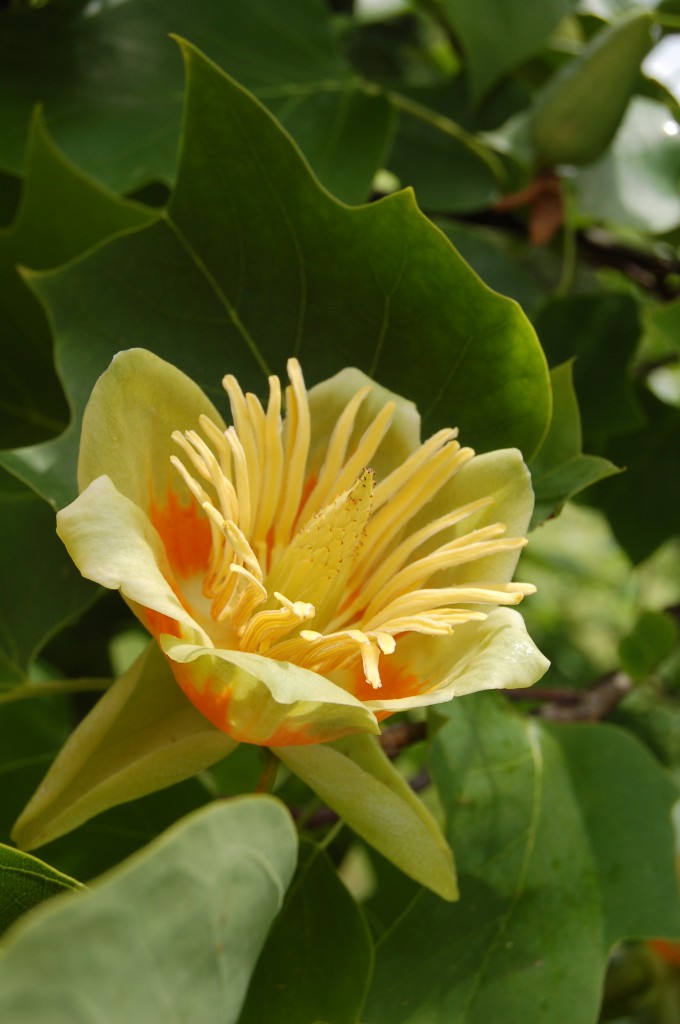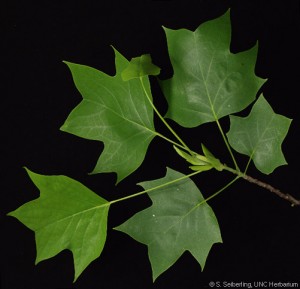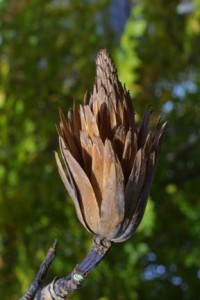Not every edible plant has to be a nutritional powerhouse. Some are “edible” by the barest of means. A good example is the Tulip Tree, Liriodendron tulipifera, said leer-ee-oh-DEN-drawn too-lih-PIFF-er-uh.
What if you read that a native plant was “used to make honey.” What would you think? Probably that the plant was cultivated for bees to make honey. Unfortunately that is not what my reference says. It say the Native Americans made honey from the Tulip Tree. That’s rather doubtful. First people don’t make honey, bees do. And more specifically honey bees are not native to North America. They came with Europeans. It doubtful until perhaps late in the game did Natives cultivate the Tulip Tree for honey. They didn’t have the bees. However, when the bees got here the flying nectar mavens did discover Tulip Trees.
Some references say Tulip Tree roots were used as a flavoring to take the bitterness out of Spruce Beer. I’ve had Spruce Beer and it does need something to make it more palatable. But one expert on Native Americans lists under “sauces and garnishes” that Tulip Trees were used to make honey. As mentioned above that’s not probable but here’s a possible answer that fits nicely with our foraging interests.
For just a short time while the tree is blossoming there is a small amount of very sweet nectar in each blossom. It is heavy and honey-flavored. You can drink it directly from the blossom. The expert was relying on old reports that probably didn’t describe how the natives used the tree. They weren’t collecting honey, they were collecting nectar. The tree was also called the Sap Poplar, perhaps because its sap is consumable. I don’t know and have not found any reference to said but it wouldn’t surprise me. As a source of nectar the tree also attracts hummingbirds, squirrels and is a host plant for tiger and spicebush swallowtail butterflies.
The genus name is bastardized Greek via Dead Latin. Liriodendron. Lirio is a Greek derivative for Lily, dendron Greek for tree, Lily Tree. Tulip is the English version of a Turkish word Tuliband. That is bastardized Persian for dulband which means turban. “Ifera” is Latin and means producing. Liriodendron tulipifera thus is “Lily Tree Producing Tulips.” The tree is also called Yellow Poplar, Tulip Poplar, White Poplar, and Whitewood.
Related to the Magnolias, the Tulip Tree can be found in eastern North America plus Texas. To see a good video on the Tulip Tree by my foraging colleague Blanche Derby, click here.
Green Deane’s Itemized Plant Profile: Tulip Tree
IDENTIFICATION: Liriodendron tulipifera, 100-foot tree, sometimes to 150 feet. Leaves alternating, simple, palmately veined, orbicular (circular and flat) 4-lobes, no teeth, 4 to 8 inches long, notched to flat top. Somewhat shaped like a tulip, light green to green. Blossom, monoecious; perfect, showy, resembling a large tulip, but high in the tree, 2.5 inches long, with yellow-green petals and an orange corolla. Fruit is cone-like with many samaras (2 inches long) falling off at maturity; each samara is 1-winged, 1.5 inches long, and curved upwards resembling the front keel of a boat, maturing August to October and falling through late fall and winter. The base whorls of samaras persist into following spring and resemble wooden flowers high in the tree.
TIME OF YEAR: Flowers appear in late spring to early summer.
ENVIRONMENT: Grows in a wide variety of soil. The effects of temperature and moisture extremes are mitigated some by the lay of the land. At the northern end of its range, yellow-poplar is usually found in valleys and stream bottoms at elevations below 1,000 feet. In southern Appalachia, it can grow on a variety of sites, including stream bottoms, coves, and moist slopes up to an elevation of about 4,500 feet. Toward the southern limit of the range, where high temperatures and soil moisture probably become limiting, the species is usually confined to moist, well-drained, stream bottoms. Optimum development occurs where rainfall is well-distributed over a long growing season.
METHOD OF PREPARATION: The blossom can be tipped and the nectar sipped out.





I’m not worried about looking silly, I just wonder… if there were no bees, how did plants get pollinated?
There were no Honey Bees. There were solitary Bumble Bees.
i see less and less Bumble Bees each year
Just for the record, there are many insects and many types of native bees that pollinate flowers. Honeybees and bumble bees are just the better known. Carpenter bees, those giant hulking bees that dig into your fence posts are a native pollinator that is on the uptick. There also wasps, hornets, flies, beetles, and many other insects that pollinate flowers.
Ah, yes, I should have felt silly! You did say “honey” bees. Thank you for clearing that up. 🙂
The basic process of honey making is evaporating nectar. There is some enzyme action, but I’m not certain that it is absolutely necessary. I think it would be possible to boil the nectar down into a syrupy honey.
Can you eat the tulip tree flower?
No. I would have said so if it were edible.
You can eat the blossoms!!
They are very tasty
Have you eaten them yourself? And if so, how?
there’s still “red-wasps” if all the bees die the wasps do fly from one flower to another I’ve seen them do it and they like the water thats on the plants and the wasps like the holly tree flowers and they like lily flowers & more.
well how would they know that its nectar
i know that these kind of tree’s have some hard wood and beach nut tree’s too and cedars and others do but not silver maples cause the wind brakes them to easy
I have many poplars in my yard, as well as a few different species of maple. One of which is a sugar maple. Oh, I will be tapping those babies (maples) to make my own maple syrup. On the flower of the poplar, is there any good way of collecting the nectar, that is, will it pour out? How can I store it? Or am I being greedy? Perhaps I can just enjoy the occasional sip of nectar here and there. May be good in my dandelion coffee. Who knows if tree sugars are better for you than cane or beet sugar? Or are they much the same?
There can be enough nectar to pour out of the tulip tree blossom. As for tree sugar… Maple syrup is 60% sucrose and 40% fructose, honey is 30% glucose, 40 fructose, 1% sucrose, agava is 70% plus fructose… As fructose is the bad stuff tree sugar would seem to be a little better than table sugar and a whole lot better than agave sugar.
I copied and pasted that into my notes. Great info to have. I must look up and see what “agave” is. I will make sure I’m ready when it’s time to tap my maples. As for the dandelion coffee, I’m going to reserve a place in my garden to grow some dandelions. Maybe with better soil I can get a bigger size root from them. And maybe throw some of those young dandy leaves in my food. They say they are a “super food”. I’ve only gotten into wild edibles in the last year, and while I’m still a bit new to it all, it has captured my interest like nothing else in a long time. Perhaps I’ve found my calling….lol…we’ll see.
Actually the used it a sap (a sweetener or treat) an alternative to honey. (But not honey) but SAP
Maybe it has sweet sap, but you can actually drink the nectar directly from the blossoms. Apparently, it makes a ton!
would it be possible to put these flowers thru a ringer to get the good stuff??
Did you receive an answer? I also am curious
I have seen these in my neighborhood and have been intrigued by the beauty of it flowers and sweetnes of its sap. What really intrigues me that the leaves ooze out very sweet sap that drips and makes the ground around it dark. However, I have never seena single fly, honey bee or ants present to feast on this sweet thing. Other sweets fruit plants besides them are abuzz by bees and ants??
Depending on where you live, this might actually be lanternflies pooping out the tree’s sap or another stress in the tree.
Cool Dean. Thanks!
I have three honeybee colonies. Tulip is known for its dark honey, but for several days, the bloom is over but one tree is a hum with honey bees attracted to moist leaves.
I was given a tulip tree last fall and thought it died in the container over winter. It was only a sprig. Then a couple months ago, I saw green along the 8-9 inch sprig so I planted it. It really took off! It had grown to over 2 foot tall with the top leaves twice as big as my hand. So heathy and beautiful. This morning, something had broken it in half and chewed on the leaves. I’m so sad, but what would’ve done this and will it come back and keep growing?
Joyce,
The best thing about tulip trees (Liriodendron tulipfera) is that if you can find some in the forest or even planted in a garden there are usually loads of seeds that sprout into little 1 ft. trees you can harvest. (Ask the homeowner first.) In Maryland I lived where there were woods with tulip trees and their offspring were everywhere. You can also gather their seeds called samaras that float to the ground and easily grow them from seed. Tulip trees are related to magnolias and have been around since 65 million years ago. Place tulip tree where there is lots of room and away from underground utilities. These trees grow several feet/year and get really huge.
Tanya
I have three honeybee colonies. Tulip is known for its dark honey, but for several days, the bloom is over but one tree is a hum with honey bees attracted to moist leaves.
Will the honeydew kill other plants